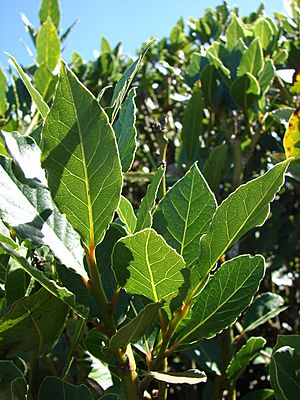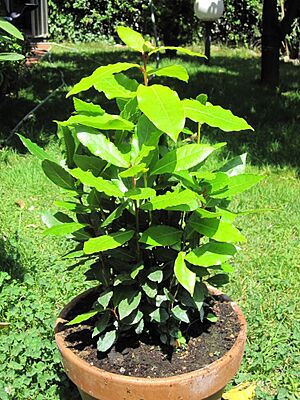Laurus nobilis facts for kids
Quick facts for kids Laurus nobilis |
|
|---|---|
 |
|
| Bay laurel (Laurus nobilis) leaves and branches | |
| Conservation status | |
| Scientific classification | |
| Genus: |
Laurus
|
| Species: |
nobilis
|
The Bay Laurel (scientific name: Laurus nobilis) is an aromatic evergreen tree or large shrub. It has smooth, green leaves and belongs to the flowering plant family called Lauraceae. This plant is originally from the Mediterranean region. Its leaves, known as bay leaves, are often used to add flavor to food when cooking.
People call it by many names, including bay tree, bay laurel, sweet bay, true laurel, or simply laurel. The Bay Laurel was very important in ancient Greek and Roman cultures. Many other plants around the world are also called "bay" or "laurel" because their leaves or smell are similar to the Laurus nobilis.
Contents
What it Looks Like
The Bay Laurel is an evergreen shrub or a small tree. Its size can vary, but it sometimes grows to be about 7 to 18 meters (23 to 59 feet) tall.
Bay Laurel plants are usually either male or female. This means that male flowers and female flowers grow on separate plants. Each flower is pale yellow-green and about 1 centimeter (0.4 inches) wide. They grow in pairs next to a leaf.
The leaves are smooth and shiny. They are usually 6 to 12 centimeters (2.4 to 4.7 inches) long and 2 to 4 centimeters (0.8 to 1.6 inches) wide. Their edges are smooth, without any teeth or jagged parts. Sometimes, the edges of the leaves can look a bit wavy. The fruit of the Bay Laurel is a small, shiny black berry-like fruit called a drupe. It is about 1 centimeter (0.4 inches) long and holds one seed inside.
Where it Grows
The Laurus nobilis is a plant that survived from ancient laurel forests. These forests once covered a large part of the Mediterranean area when the climate there was much wetter.
As the Mediterranean region became drier during the Pliocene era (millions of years ago), the laurel forests slowly disappeared. They were replaced by plants that could handle dry weather better. Most of the last laurel forests in the Mediterranean are thought to have vanished about ten thousand years ago. However, some small parts of these forests still exist today. You can find them in the mountains of southern Turkey, northern Syria, southern Spain, north-central Portugal, northern Morocco, the Canary Islands, and Madeira.
How People Use It
For Food
The Bay Laurel plant gives us popular herbs and a spice that are used in many different recipes. They are especially common in Mediterranean cooking. Most often, the fragrant leaves are added whole to Italian pasta sauces. People usually take the whole leaves out of the dish before serving, unless they are just used as a simple decoration. Whole bay leaves can stay fresh for about one year if stored properly.
Ground bay leaves, however, can be eaten safely. They are often used in soups and stocks. Dried laurel berries and oil pressed from the leaves can also be used as strong spices. The wood can even be burned to add a strong smoky flavor to food.
As an Ornamental Plant
Laurus nobilis is grown widely as an ornamental plant (a plant grown for its beauty). It thrives in places with a Mediterranean climate or an oceanic climate. In colder areas, people grow it as a houseplant or in greenhouses.
It is often used in topiary, which is the art of shaping trees and shrubs. Gardeners can make single straight stems with ball-shaped, box-shaped, or twisted tops. It is also used to create low hedges. However, it grows slowly, so it might take several years to reach the height you want. The Royal Horticultural Society has given the Bay Laurel, along with some special types like the 'Aurea' (gold form) and 'angustifolia' (willow-leaved form), their Award of Garden Merit.
One common problem for ornamental laurels is a tiny insect called Trioza alacris. This insect causes the edges of the leaves to curl and thicken, forming a small, dead lump where the insect's young grow. Another insect that affects the plant is Coccus hesperidum.
In Traditional Medicine
In herbal medicine, watery liquids made from bay laurel have been used to help clean and heal open wounds. It is also used in massage and aromatherapy, which uses plant scents for well-being. A folk remedy for rashes caused by poison ivy, poison oak, and stinging nettle is a poultice (a soft, moist mass) soaked in boiled bay leaves.
The ancient Roman writer Pliny the Elder wrote that laurel oil was believed to help with many conditions. These included muscle problems, headaches, ear infections, and joint pain.
Other Uses
Laurel oil is a key ingredient that gives Aleppo soap its special scent.
Symbolism and History
Ancient Greece
In ancient Greece, the plant was called daphne. This name came from a myth about a mountain nymph named Daphne. In the story of Apollo and Daphne, the god Apollo fell in love with Daphne. When he tried to charm her, she asked Gaia (Mother Earth) for help. Gaia then turned Daphne into a laurel tree. Apollo, sad about this, made wreaths from the tree's leaves to comfort himself.
The ancient Greeks used bay laurel to make the laurel wreath, which was a symbol of high status and victory. A laurel wreath was given as the prize at the Pythian Games. These games honored Apollo, and the laurel was one of his symbols.
According to some writers, the priestess of Apollo, known as the Pythia, would chew laurel leaves from a sacred tree inside the temple. This was believed to help her enter a trance and give her famous prophecies. People who received good predictions from the Pythia were crowned with laurel wreaths. This showed that Apollo favored them.
Rome

The symbolism of the laurel continued in Roman culture. Romans saw the laurel as a symbol of victory. It also represented immortality, cleansing rituals, good fortune, and health. The words baccalaureate (a college degree) and poet laureate (a poet honored for their achievements) come from the laurel. Expressions like "assume the laurel" and "resting on one's laurels" also come from this tradition.
Pliny the Elder said that laurels were not allowed to be burned on altars to honor gods. He believed the laurel protested by crackling loudly in the fire, showing it hated such treatment.
The laurel was very important to Roman Emperors, starting with Augustus. Two laurel trees stood at the entrance to Augustus's house on the Palatine Hill in Rome. This house was connected to the Temple of Apollo Palatinus, which Augustus had built. So, the laurels showed Augustus's victory in wars and his close connection to Apollo.
A story says that Augustus's wife, Livia, planted a laurel sprig at her villa after an eagle dropped a hen with a sprig in its beak onto her lap. This sprig grew into a large tree, which then created a whole grove of laurel trees. Later Emperors added to this grove when they celebrated a victory parade. Emperors in the Julio-Claudian dynasty (the first Roman imperial family) all got their Laurel wreaths from Livia's original tree. It was seen as a bad sign for the dynasty when the entire grove died during the reign of Nero, shortly before he was killed.
Rome's second Emperor, Tiberius, wore laurel wreaths during stormy weather. People widely believed that laurel trees were safe from lightning strikes, and wearing them would protect you. One reason for this belief is that laurel does not burn easily and makes loud crackling sounds when it does burn. This led ancient Romans to think the plant had a "heavenly fire spirit" and was therefore "immune" to threats like fire or lightning.
In modern Italy, graduating students wear laurel wreaths as a crown.
East Asia
In ancient China, there was a myth about the phases of the moon. It involved a huge forest or tree on the moon that quickly grew and lost its leaves and flowers every month. Later, this story was sometimes linked to a woodsman named Wu Gang. He was punished by having to cut down a tree that kept growing back. This tree was originally thought to be a type of sweet osmanthus plant. Its flowers are still used to flavor wine and sweets for the Mid-Autumn Festival.
Over time, in English, this moon tree became associated with the cassia tree. In modern Chinese, it is now linked to the Mediterranean laurel. By the Qing dynasty, a Chinese saying "pluck osmanthus in the Toad Palace" meant passing the difficult imperial examinations, which were held around the time of the lunar festival. This idea of laurels being linked to victory and success, similar to Europe, led to the Mediterranean laurel being called the "Moon gui" in Chinese.
Finland

The laurel leaves on the coat of arms (official symbol) of Kaskinen, Finland, might refer to local flowering plants. However, their origin might also be connected to the name of the Bladh family. Two members of this family, a father and son, helped the village gain town rights and become a trading center. The name "Bladh" sounds like the Swedish word for "leaf."
What's Inside the Plant
The most common ingredient found in laurel essential oil is something called 1,8-cineole, also known as eucalyptol. The leaves contain about 1.3% essential oils. These oils are made up of different chemicals that give the plant its smell and taste.
Both essential oils and fatty oils are found in the fruit of the Bay Laurel. These oils are extracted by pressing the fruit and using water. The fruit contains up to 30% fatty oils and about 1% essential oils. This laurel oil is the special ingredient that gives Aleppo soap its unique qualities.
Images for kids
See also
 In Spanish: Laurel para niños
In Spanish: Laurel para niños







